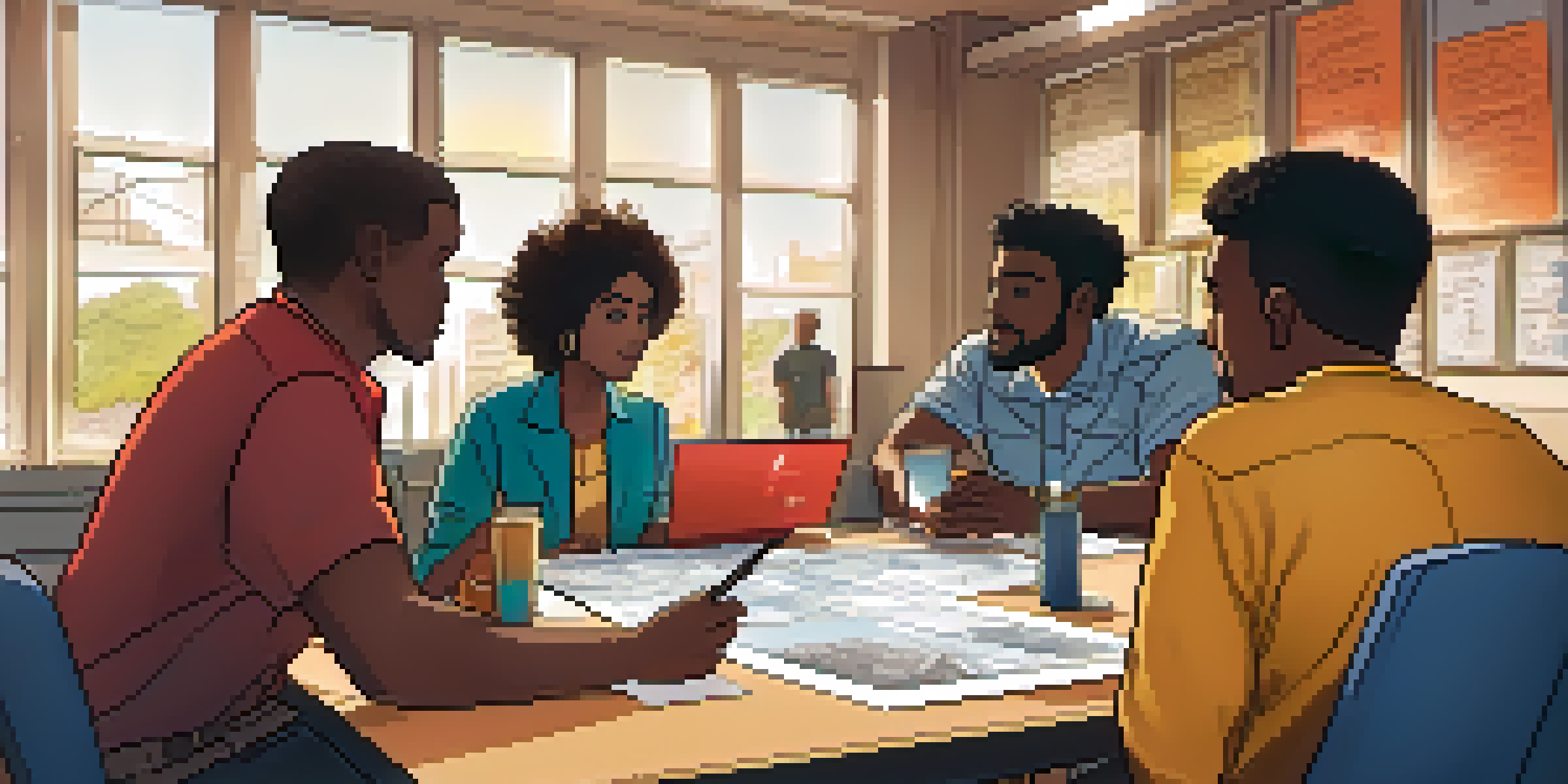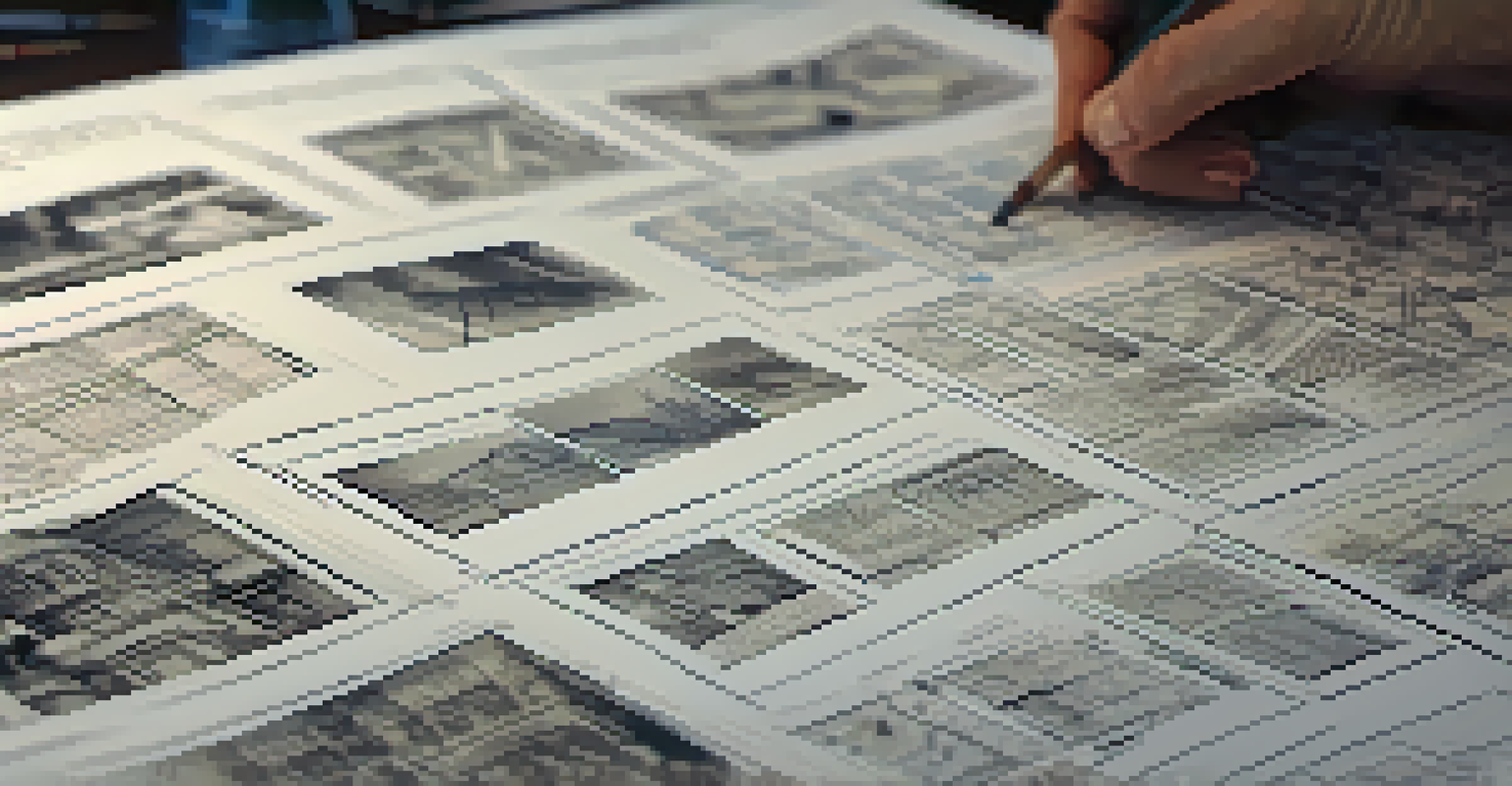Storyboarding Techniques for Visual Storytelling in Film

Understanding the Importance of Storyboarding in Film
Storyboarding is a crucial step in the filmmaking process, serving as a visual blueprint for the entire project. It allows filmmakers to plan shots, sequences, and transitions, ensuring that every frame aligns with the narrative vision. By translating scripts into visuals, storyboarding fosters clear communication among the crew and helps identify potential issues early on.
A storyboard is a visual representation of the script that helps filmmakers plan shots and transitions more effectively.
Imagine trying to build a house without blueprints; you'd likely encounter a range of problems! Similarly, storyboards guide filmmakers through the creative journey, allowing them to visualize how scenes will unfold. This process not only saves time on set but also enhances creativity by enabling directors to experiment with ideas before actual filming.
Ultimately, effective storyboarding can elevate the storytelling experience, making it easier to convey complex emotions and themes. Whether you're a seasoned director or a novice filmmaker, understanding the significance of storyboarding is the first step toward crafting a compelling visual narrative.
Key Elements of a Successful Storyboard
A successful storyboard includes several key elements that contribute to clear visual storytelling. These elements often consist of sketches or images representing each shot, along with notes on camera angles, movements, and dialogue. This comprehensive approach allows filmmakers to visualize how each scene fits into the larger narrative.

Consider each storyboard frame as a mini comic strip; it tells a part of the story while hinting at the emotions and actions to come. Additionally, incorporating details like lighting and sound can further enhance each frame's impact. This attention to detail helps ensure that everyone involved in the production understands the director's vision.
Storyboarding as a Visual Blueprint
Storyboarding serves as a crucial visual guide that helps filmmakers plan shots and communicate their narrative vision effectively.
Ultimately, the more information you include in your storyboard, the more effective it will be in guiding your film's production. By thoughtfully considering each element, filmmakers can create a cohesive and engaging visual experience that resonates with audiences.
Different Storyboarding Techniques to Explore
There are several storyboarding techniques that filmmakers can utilize, each serving unique purposes and styles. Traditional hand-drawn storyboards are popular for their flexibility and personal touch, allowing artists to convey emotions and actions through their unique artistic styles. On the other hand, digital storyboarding tools provide efficiency and ease of editing.
Storyboarding is essential; it allows you to visualize your film before you shoot it, saving time and money in the production process.
Another approach is the use of animatics, which take storyboarding a step further by animating the frames to create a rough version of the final product. This technique helps filmmakers visualize movement and timing, making it easier to identify pacing issues before shooting. Think of animatics as a dress rehearsal for your storyboard, giving you a clearer sense of how everything will flow.
Experimenting with different techniques can help you find the best fit for your project. Whether you choose traditional methods or modern digital tools, the key is to find a technique that enhances your storytelling process.
Incorporating Visual Style into Storyboards
Visual style is an essential aspect of storytelling that can be effectively incorporated into storyboards. This involves considering the color palette, framing, and overall aesthetic that will define the film. By establishing a consistent visual language, filmmakers can evoke specific emotions and themes that resonate with their audience.
For example, a darker color palette may suggest a more serious narrative, while vibrant colors might indicate a lighthearted story. By including these stylistic choices in the storyboard, filmmakers can communicate their artistic vision more clearly to the crew. This foresight ensures that every aspect of the production aligns with the intended mood.
Key Elements Enhance Visual Storytelling
Incorporating sketches, notes, and details like lighting and sound in storyboards ensures a cohesive and engaging visual narrative.
Ultimately, the visual style in your storyboards can set the tone for the entire film. By carefully choosing how you visually represent each scene, you can create a captivating and immersive experience for viewers.
Balancing Creativity and Practicality in Storyboarding
When storyboarding, it's crucial to strike a balance between creativity and practicality. While it's essential to explore imaginative ideas, practical considerations like budget, location, and time constraints must also be taken into account. This balancing act helps ensure that the creative vision remains achievable within the project's limitations.
Think of it as a tightrope walk; on one side lies wild creativity, while the other holds the realities of production. By being mindful of both aspects, filmmakers can create storyboards that inspire while remaining grounded. This approach often leads to innovative solutions that enhance storytelling without compromising feasibility.
Remember, the most compelling stories often emerge from the intersection of creativity and practicality. By embracing both elements in your storyboarding process, you can craft films that are not only imaginative but also achievable.
Collaborating with Your Team During the Storyboarding Process
Collaboration is key in the storyboarding phase, as it fosters a cohesive creative vision among the entire team. Sharing storyboards with cinematographers, production designers, and other crew members allows for valuable input that can enhance the overall project. By inviting diverse perspectives, filmmakers can uncover new ideas and solutions that may have otherwise gone unnoticed.
Consider your storyboard as a living document that evolves through collaboration. Regular discussions with your team can help refine ideas, clarify intentions, and ultimately strengthen the narrative. This teamwork creates a sense of ownership and investment among everyone involved, leading to a more unified production.
Collaboration Strengthens Storyboarding
Engaging the entire team during the storyboarding process fosters a shared creative vision and leads to a more unified production.
In the end, collaboration transforms storyboarding from a solitary task into a shared creative journey. By engaging your team throughout the process, you can cultivate a richer storytelling experience that resonates on multiple levels.
Finalizing Your Storyboard for Production
Once you’ve developed your storyboard, the finalizing process is crucial to ensure readiness for production. This step involves reviewing all frames, making necessary adjustments, and clarifying any ambiguous elements. It's essential to confirm that the storyboard effectively communicates the intended story and visual style before heading to set.
Think of this stage as polishing a diamond; it’s about refining every detail until it shines. Gathering feedback from the team during this phase can help catch any potential issues and solidify the storyboard's effectiveness. Additionally, creating a digital version can enhance accessibility and facilitate easy sharing among crew members.

Ultimately, a well-prepared storyboard sets the stage for a smooth production process. By dedicating time to finalize your storyboard, you can enhance the likelihood of capturing your creative vision on screen.